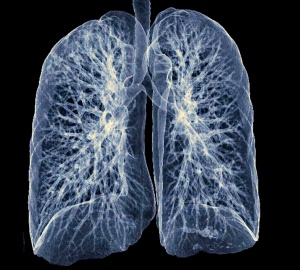
Dr Josie Bryant leads the Lung Microbiome group at the Wellcome Sanger Institute and presented some of her group’s findings at the Festival of Genomics & Biodata 2025. Understanding the respiratory microbiome at a spatial level provides crucial insights into the progression and treatment of chronic lung diseases. These conditions arise from a combination of genetic and non-genetic factors, with cystic fibrosis (CF) and chronic obstructive pulmonary disease (COPD) being prime examples. In such diseases, impaired lung clearance mechanisms lead to a high microbial load, resulting in persistent infections and acute exacerbations.
The complex microbiome in cystic fibrosis
CF is an inherited condition caused by mutations affecting mucociliary clearance, creating a destructive feedback loop of infection, tissue damage, and increased susceptibility to further infections. The CF microbiome is characterised by a dominance of pathogenic species such as Pseudomonas aeruginosa and Staphylococcus aureus, while mid-to-low-frequency bacteria are often labelled as commensals, though their role in disease remains uncertain. Current research has only established correlations rather than causation, making it difficult to determine whether and how these infections should be treated. A mechanistic understanding of their contribution to lung disease is needed.
Historically, research has focused on individual pathogens. For example, Mycobacterium abscessus (MA) infection in CF patients is associated with accelerated lung function decline and can be fatal due to its natural resistance to many antibiotics. MA exhibits two distinct morphotypes, with the rough type being more virulent. Genetic analyses have identified frequent mutations in a small group of genes linked to antimicrobial resistance (AMR) and a tight transcriptional network crucial for survival in human macrophages. These findings suggest that bacterial evolution in patients is closely tied to adaptations against the human immune system.
The importance of spatial context in microbiome research
CF patients with MA infections tend to have co-infections, underscoring the complexity of the lung microbiome and immune interactions. This has led researchers to study microbial communities longitudinally and within their tissue microenvironment using lung biopsies and spatial transcriptomics.
A pivotal discovery in this field came from studying the spatial organisation of bacteria in lung tissues. Analysing tissue samples from CF patients revealed greater clonal diversity of MA in lung tissue compared to sputum samples. Furthermore, distinct clones were observed in different tissue regions, highlighting the necessity of studying microbiomes in their native tissue context rather than relying solely on sputum samples.
Advances in spatial transcriptomics
The most successful analyses have come from explanted lung tissues of CF patients. Initially, bulk RNA sequencing provided broad microbial profiles within different lung regions. However, spatial transcriptomics methods, such as Visium for formalin-fixed paraffin-embedded (FFPE) tissues, were later optimised to detect bacterial transcripts within tissue sections.
More recently, Xenium, a fluorescence imaging-based spatial method, has been employed to overlay transcriptomic signals onto lung images. This method has revealed bacterial transcription hotspots lining airways, supporting previous observations of Pseudomonas biofilms in CF lungs. By incorporating probes for Pseudomonas virulence systems, researchers have correlated bacterial activity with specific lung microenvironments. The single-cell resolution of Xenium also allows for detailed analyses of interactions between Pseudomonas and immune cells, shedding light on the heterogeneity of immune responses to infections.
Future directions
By leveraging these advanced spatial transcriptomic techniques, researchers aim to uncover how pathogens behave in different lung regions and how microbial-microbial interactions influence disease progression. Understanding these dynamics at a tissue level will be critical in developing targeted therapies and improving clinical management of chronic lung infections. The next steps involve further refining these techniques to capture real-time interactions and identify potential therapeutic targets to disrupt pathogenic biofilms and enhance immune responses.
